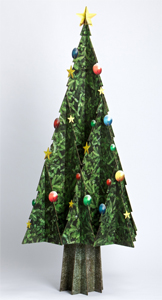Fresh trees.
Many authorities on the subject agree that the greenest option is a living, plantable bulb tree. These trees can be transplanted outdoors post-holiday season. Keep in mind that the bulbed tree must be left indoors until such a time when the outside temperature is similar to the internal temperature; if the tree is moved outdoors before this, the shock of the cold could kill it.
If you don't have the appropriate space for an evergreen, consider renting one from a local market grower or donating the tree, either to a tree adoption or urban reforestation service.
A fresh tree can be a great option if you intend on recycling it or converting it to mulch or compost. Brian Clark Howard at the Daily Green states that while deforestation is rarely an issue (most Christmas trees are farm-raised), these trees are often heavily sprayed with pesticides on large, conventional operations and shipped from great distances, contributing to environmental degradation and increased air pollution.

Instead, search for trees available from local sustainable or organic farms. These trees tend to be more expensive, but by paying a little more you'll help out your local economy and cut down on CO2 emissions. Whichever fresh tree you choose, be sure to keep it well-watered to prevent it from becoming a fire hazard. If you’re near the Evergreen Brick Works, you can learn how to care for your fresh tree on December 8 at one of their DIY Workshops. In Montreal you can find the Quinn Farm which offers eco-friendly Christmas trees for purchase. You can even return your tree to the farm after the holidays, where they will compost it or convert it into mulch!
Artificial trees.
What about artificial trees? According to the University of Illinois, around 80% of artificial trees are manufactured in China and shipped to North America. The fossil fuels burned to transport the trees contributing to global warming and the trees themselves are typically made of polyvinyl chloride (PVC). The dangers of PVC are still widely controversial; Greenpeace has stated that when PVC burns, some 100 toxic compounds are produced.
It’s also important to note that while fresh trees can cause mold allergies as they dry out, artificial trees can collect dust and can contribute to allergy symptoms.
What other options are there? See about sourcing a locally manufactured tree, which are also less likely to be contaminated with lead or other toxins, and encourage your local retailers to carry Canadian or U.S.-made trees to reduce the environmental impact.
Although most trees are plastic, the majority of artificial trees are not recyclable or biodegradable and will take many centuries to break down in landfills. Aim to keep your artificial tree for at least 10 years (20 is better), which is approximately how long it takes for an artificial tree to compete with the carbon benefits of a real one. If your artificial tree is at the end of its life, consider donating it to local shelters and charities instead of throwing it away. Or in place of a traditional artificial tree, consider a cardboard one!

Get creative!
Many households are choosing to celebrate the festivities with an untraditional option. Try making your own tree by drawing one on a wall painted with chalkboard paint. Hang an image of a tree in the form of a textile or try assembling one out of cardboard. Looking to get creative this year? There are great options for small spaces as well as for those on a limited budget. By thinking outside the box you can save money and the environment at the same time.
This year, my roommates and I will be celebrating with a cardboard tree, a few lights and some strategically placed mistletoe. What will you do this year?
Sarah Berneche is a contributing writer and editor for LEAF. She has a B.A. and M.A. in English Language, Literature and Creative Writing from the University of Windsor, and attended Humber College's Creative Book Publishing post-graduate programme, where she specialized in editing and marketing. Sarah works, writes, cooks, and loves in Toronto. Follow her on twitter @sarahberneche.
